![]()
![]()
![]()
Use LEFT and RIGHT arrow keys to navigate between flashcards;
Use UP and DOWN arrow keys to flip the card;
H to show hint;
A reads text to speech;
51 Cards in this Set
- Front
- Back
|
Most communication b/w cells is mediated by what? |
extracelular signal molecule |
|
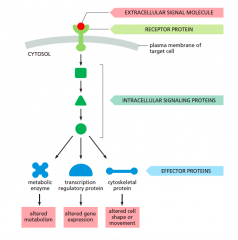
|
-signal recieved by receptor prtn. found on cell surface or intracellular
-binding of a signal to a receptor activates one or more intracellular signaling prtns, they process the signal and deliver it to target effector prtns.
|
|
|
four forms of intercellular signaling |
1. contact-dependent 2.paracrine 3.synaptic 4.endocrine |
|
|
contact-dependent signalling |
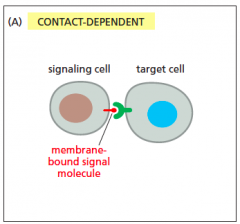
signal only affects target cell it contacts
signal attached to signalling cell |
|
|
paracrine signalling |
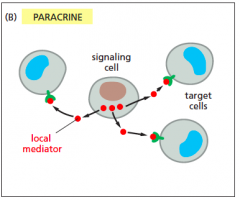
signalling cell SECRETES signal which affects target cells
acts only in local environment
AUTOCRINE signalling: cells respond to THEIR OWN signals |
|
|
synaptic signalling |
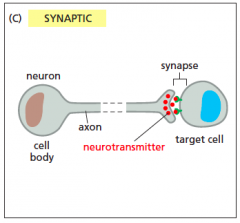
long distance bw neurons |
|
|
endocrine signalling |

cells secrete hormones into bld stream to signal many other cells
LONG DISTANCE |
|
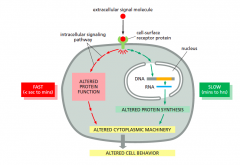
How fast is the response to a signal? |
speed depends on the target effector proteins
very fast: ion channels, action pot (ms)
fast: change in movement, secretion, metabolism(sec-ms)
slow: change in gene expression, prtn synth, cell growth, and division (min-hours)
|
|
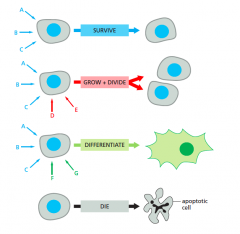
|
different combinations of signals =different response |
|
|
acetylcholine |
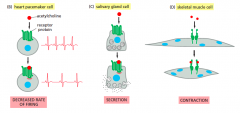
|
|
|
Receptors |
mostly transmembrane proteins on surface of cell- cell surface receptors
most signal molec. are hydrophilic, and cannot enter cell
receptor proteins can also be found inside the cell- intracellular receptors
requires signal molcules to be small or hydrophobic to crross memb. and enter cell |
|
|
Intracellular receptors |
signals enter cell by diffusion
ligands: NO |
|
|
NO - Nitric Oxide |
Small signalling molec. that can cross the plasma memb.
ligand for intracellular receptor
acts on smooth muscle of blood vessles
FUNCTION: relaxes SM, bld vessles dilate, incr bld flow |
|

Intracellular Receptors |
1.Ach released by neuron, binds to receptor on endothelial cell surface 2.this sets off an intracellular signaling pathway that activates NO synthase in the endothelial cell 3. No synthase, makes NO, it diffuses across membrane into SM cells 4.NO binds and activates the intracellular receptor guanylyl cyclase, which produces GTP->cGMP 5.cGMP causes muscle relax
|
|
|
Drugs that act on Nitric Oxide signalling in SM cells |
nitroglycerine- treats angina.. converted to NO, relaxes bld vessels
viagra- treats erectile dysfunction... inhibits enzyme cGMP phosphodiesterase in the penis, which converts cGMP-> GMP |
|
|
steriod hormones: ex? function? |
cortisol, sex hormones: estradiol , testosterone, vitamin D
hydrophobic signaling molecules that can cross pm, and bind to nuclear receptors
function: alter gene expression |
|
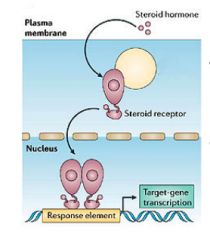
What happens when steroids bind to intracellular receptors? |
nuclear receptors bind to specific DNA sequences (response elements)
THIS: intiates, represses, or transcribes an adjacent gene |
|
|
where are intracellular receptors found? |
some: inactive nuclear receptors are found in the cytosol, but enter nucleus only after steroid hormones bind
some: inactive nuclear receptors are already bound to DNA in the nucleus |
|
|
Cell-surface receptors |
must convert extracellular signal to intracellular sinal (signal transduction)
1. ion channel coupled receptors 2.G prtn coupled receptors 3.enzyme coupled receptors |
|
|
ion-channel-coupled receptors |

signal=neurotransmitter receptor=ion channel |
|
|
GPCRs
G-protein-coupled receptors |

act indirectly by regulating the activity of a trimeric GTP binding protein (G prtn)
activated G prtn acts on the target prtn ((enzyme or ion channel) |
|
|
enzyme coupled receptors |

enzymes or they activate enzymes when bound by a signal molec.
majority: protein kinases (phophorylate proteins when active)
|
|
|
Properties of Cell Surface Receptors |
signal recieved by cell-surface receptor, and relays to intracellular signaling molec. types: 1. intracellular signaling proteins some act like switches: inactive-> active (ex. phosphorylation, GTP binding)
2. second messengers (cAMP, Ca2+, DAG): Aplify and spread the signal to other parts of the cell |
|
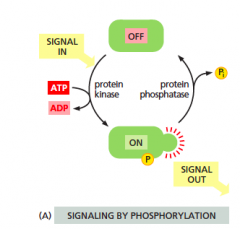
phosphorylation |
associated with cell surface receptors
intracellular signaling protein that act as molecular switch
Protein kinase: phosphorylates a protein to activate it (ON)
protein phosphatase removes phosphate to de-activate the protein (OFF)
|
|
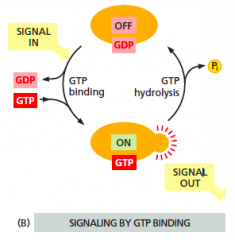
GTP binding or monomeric GTPase |
associated with cell surface receptors -intracellular signaling protein that act as -molecular switch
(ON) GTP is bound to GTPase (OFF) GDP is bound to GTPase
Regulated by 2 prtns: 1. GTPase activating prtn (GAP)-mediates hydrolysis of GTP to GDP=INACTIVATES
2. guanine nucleotide exchange factor (GEF)-promotes xchange of GDP with GTP=ACTIVATES
|
|
|
GTPase activating prtn and guanine nucleotide exchange factor... what are their functions? |

1. GTPase activating prtn (GAP)-mediates hydrolysis of GTP to GDP=INACTIVATES
2. guanine nucleotide exchange factor (GEF)-promotes xchange of GDP with GTP=ACTIVATES |
|
|
many signaling pathways occur in a single cell... how are pathways kept specific and avoid cross talk? |
specificity of signal pathways can be enhanced by the formation of signaling complexes
this keeps interacting signaling molec. in close proximity
1.scaffold proteins 2.assembly on an activated receptor 3.assmbly on phosphoiositides |
|
|
Scaffold Proteins |
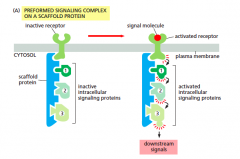
Scaffold: structure that suppors ( like an egg bin)
hold intracellular signaling proteins close to the receptor
ONLY activated WHEN the receptor is activated |
|
|
Assembly on an activared receptor |

intracellular signaling proteins become activetes ONLY after binding to an activated receptor
RECEPTOR=Docking site |
|
|
Assembly on phosphoinositides |
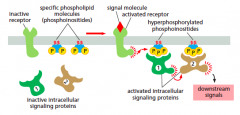
activated receptors phosphorylate phophoinositides which then act as docking site for intracellular signalling proteins |
|
|
how is a response to a signal regulated ? |

feedback loops |
|
|
positive feedback loop |
response to a signal stimulates its own activation
short term response becomes a long term change |
|
|
negative feedback loop |
response to a signal inhibits its own activation
can limit the level of response and make the system less sensistice to the signal
DESENSITIZATION or ADAPTATION |
|
|
desensitization or adaptation mechanisms |

limit response to a signal, even when signal is still present
often involve: phosphorylation or ubiquitylation of the receptor proteins |
|
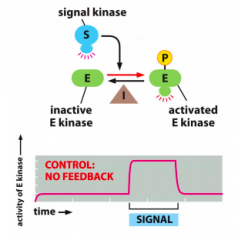
|
NO feedback |
|
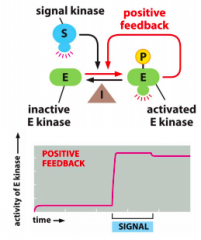
|
POSITIVE feedback |
|
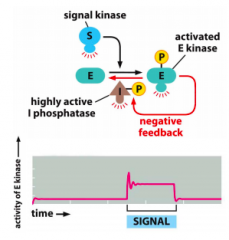
|
NEGATIVE feedback |
|
|
compare and contrast the four forms of intercellular signalling |
affected cells -contact-dependent: only target cell, which receives the signal from a signalling cell, is affected -paracrine: signals are secreted by a signalling cell, which act only on cells in the local environment (-autocrine signalling: cells respond to their own signals) -synaptic: signalling between two neurons over a long distance endocrine: cells secrete hormones into the blood to signal many cells over a long distance |
|
|
what are the different speeds of different signalling responses? |
depends on the target effector proteins
very fast: ion channels, action potential (~ms)
fast: change in movement, secretion, metabolism (~s's-mins)
slow: change in gene expression, protein synthesis, cell growth and division (~mins-hrs) |
|
|
What determines how a cell responds to a signal? |
depends on the combination of signals it receives
different combinations of signals can produce a different response in the same cell
different receptors are used for different signals |
|
|
how can a signalling molecule be versatile? give an example |
a signalling molecule can have different effects on different types of cells
same signal can bind to same receptor on different cell and produce different response (different effector proteins)
same signal can bind to different receptor and produce different response (different signalling pathway)
e.g. acetylcholine |
|
|
receptor structure/properties |
-most are transmembrane proteins on surface of cell (cell surface receptors) -most signal molecules that bind to cell surface receptors are hydrophilic (cannot enter cell) -instead have to initiate a signal transduction pathway
-some are intracellular receptors. signal molecules here are small and/or hydrophobic ; cross plasma membrane directly to enter cell and bind to receptor -e.g. nitric oxide (NO) (gas): relaxes smooth muscle; dilates blood vessels to allow increased blood flow -e.g. steroid hormones: bind to nuclear receptors (act to alter gene expression) |
|
|
detailed pathway involving acetylcholine, nitric oxide, smooth muscle relaxation |
1) acetylcholine released by a neuron binds to a receptor on the endothelial cell surface
2) sets off intracellular signalling pathway that activates NO synthase in the endothelial cell
3) activated NO synthase makes NO, which rapidly diffuses across cell membranes into SM cells
4) NO binds to and activates the intracellular receptor guanylyl cyclase, which produces cGMP from GTP
5) cGMP causes muscle relaxation |
|
|
drugs that act on NO signalling in SM cells |
nitroglycerine: treatment for angina; is converted to NO, which relaxes blood vessels
Viagra: inhibits cGMP phosphodiesterase in the penis, which converts cGMP to GMP |
|
|
intracellular signalling with steroid hormones |
-steroid hormones bind to steroid receptors on nuclear membrane -receptors (either in cytosol when inactive or already bound to DNA when inactive) bind to DNA sequences called response elements to initiate or repress the transcription of an adjacent target gene |
|
|
three major classes of cell surface receptors |
1) ion channel-coupled receptors -signal = neurotransmitter; receptor = ion channel -already covered
2) G protein-coupled receptors -act indirectly by regulating the activity of a trimeric GTP binding protein (G protein) -activated G protein then acts on the target protein (enzyme or ion channel)
3) enzyme-coupled receptors -are themselves enzymes or activate enzymes when bound by a signal molecule -majority are protein kinases; phosphorylate specific sets of proteins when activated |
|
|
general, generic cell surface receptor signalling pathway |
-extracellular signalling molecule binds to receptor protein on plasma membrane -this binding activates one or more intracellular signalling molecules, which process the signal and deliver it to target effector proteins |
|
|
two types of intracellular signalling molecules in cell surface receptor signalling pathways |
1) intracellular signalling proteins
2) second messengers (small molecules e.g. cAMP, calcium ion, DAG) -amplify and spread the signal to other parts of the cell |
|
|
some intracellular proteins (for cell surface receptor signalling pathways) act as molecular switches
what does this mean? give two examples |
switch from inactive to active state until another process switches them back
e.g. phosphorylation -protein kinase phosphorylates a protein to activate it (turn the switch on) -protein phosphatase removes phosphate to deactivate the protein (turn switch off)
e.g. GTP binding of monomeric GTPase -when GTP is bound to monomeric GTPase, the protein is on (regulated by guanine nucleotide exchange factor (GEF): promotes exchange of GDP for GTP; activates) -when GDP is bound to monomeric GTPase, the protein is off (regulated by GTPase activating protein (GAP): mediates hydrolysis of GTP to GDP; inactivates) |
|
|
problem: many signalling pathways occur in a single cell. how are pathways kept specific and avoid crosstalk? |
specificity of signal pathways can be enhanced by the formation of signalling complexes; keep interacting signalling molecules in close proximity
1) scaffold proteins -hold intracellular signalling proteins close to the receptor -only activated when the receptor is activated
2) assembly on an activated receptor -intracellular signalling proteins become activated only after binding to an activated receptor -receptor acts as a docking site
3) assembly on phosphoinositides -activated receptors phosphorylate phosphoinositides, which then act as docking sites for intracellular signalling proteins |
|
|
how is a response to a signal regulated? |
feedback loops
positive feedback loop -response to a signal stimulates its own activation -allows the response to be long-term
negative feedback loop -response to a signal inhibits its own activation -can limit the level of response and make the system less sensitive to the signal (desensitization or adaptation) |

